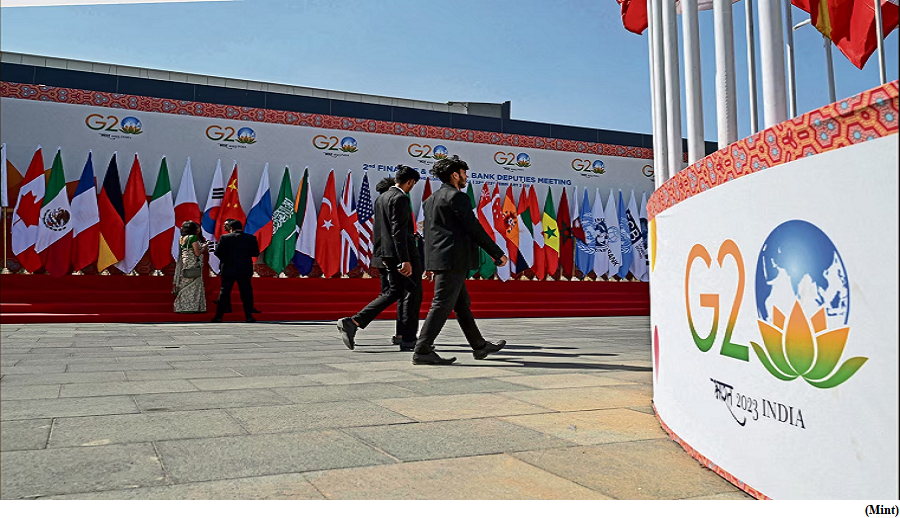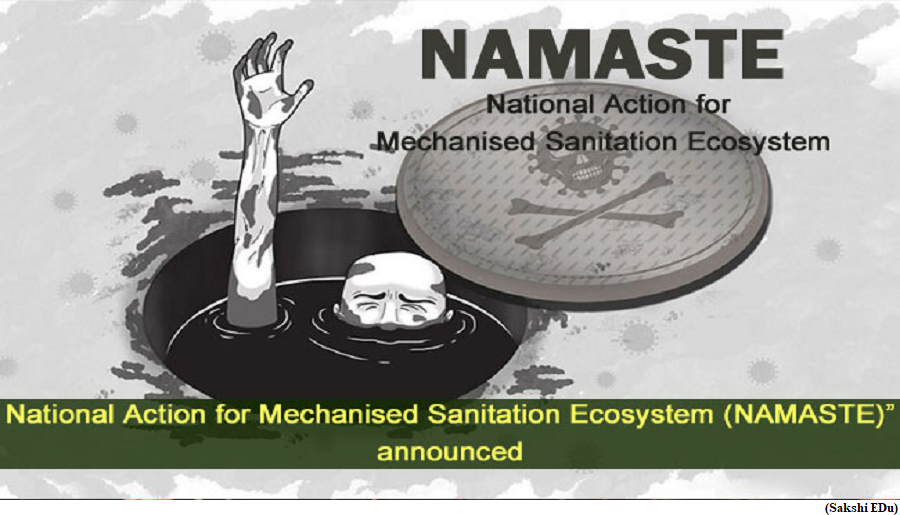G20 Trade and Investment Ministers Meeting (TIMM) (GS Paper 3, Economy)

Why in news?
- The G20 Trade and Investment Ministers’ meeting concluded at Jaipur, recently.
- Under India’s Presidency, the G20 Trade and Investment Ministerial reached a groundbreaking consensus on five concrete and action-oriented deliverables which have been adopted in the Outcome Document of Trade Ministerial Meeting.
Five concrete and action-oriented deliverables:
Principles on digitalization of trade documents:
- Adoption of High-Level Principles on digitalization of trade documents wherein the G20 Ministers have enunciated 10 broad principles that comprehensively cover various dimensions of an effective transition to paperless trade.
- These principles will provide guidance to the countries in implementing measures related to the cross-border exchange of electronic trade-related data and documents, emphasizing the need for a secure interoperable and transparent paperless cross-border trade environment.
- Moreover, inclusivity has been prioritized as one of the principles, ensuring that such a transition accommodates businesses of all sizes.
Jaipur Call for Action:
- G20 Ministers also issued a Jaipur Call for Action for enhancing access to information for MSMEs.
- The Ministers called upon the International Trade Center (ITC), Geneva to work on a detailed implementation plan, in consultation with UNCTAD and WTO, for upgradation of ITC’s Global Trade Helpdesk which would address the informational gaps faced by MSMEs.
G20 Generic Mapping Framework for GVCs:
- The Ministers also endorsed a G20 Generic Mapping Framework for GVCs which contained key building blocks of data, analysis, and representation of GVC data.
- The framework also advocated to identify key dimensions to help evaluate the resilience of GVCs both at the sectoral and product levels.
- Moreover, guiding principles for collaboration to address the need for keeping critical GVCs resilient and robust were also enunciated in the framework.
Sharing of best practices on MRAs:
- G20 Ministers welcomed the voluntary sharing of best practices on Mutual Recognition Agreements (MRAs) for professional services and supported the development of a Presidency’s Compendium of best practices on MRAs for Professional Services.
- The compilation of good practices will spur successful entering into MRAs which will enable recognition of technical qualifications our doctors, nurses, lawyers, architect and other professionals by other countries.
G20 Standards Dialogue in 2023:
- G20 Ministers acknowledged the importance of mutual dialogues to reduce regulatory divergences and associated trade costs and also to prevent unnecessary trade frictions, monitor trade and investment-related measures and solve existing irritants.
- G20 Ministers welcomed the Presidency’s suggestion to hold a G20 Standards Dialogue in 2023 that will bring together members, policymakers, regulators, standard-setting bodies and other stakeholders to discuss topics of common interest such as good regulatory practices and standards.
Way Forward:
- In her keynote address, the Director General of the World Trade Organization, exhorted all the G20 Ministers to narrow down realistic deliverables for agreement at the WTO’s 13th Ministerial Conference (MC13) in early 2024.
- In this regard, G20 Ministers reaffirmed the essential role of the multilateral trading system with the WTO at its core.
- They reiterated their commitment to strengthening the rule making arm of the WTO and underscored the importance of the ongoing negotiations in the WTO.
National Action for Mechanised Sanitation Ecosystem (NAMASTE)
(GS Paper 2, Social Justice)
Context:
- Although, with the efforts under Self Employment Scheme for Rehabilitation of Manual Scavengers (SRMS) and other efforts of the Government, the menace of manual scavenging has been almost eliminated, a number of sewer/septic tank related deaths due to hazardous cleaning of sewers and septic tanks, are reported in the press from time to time.
- Such cases are taken up with the concerned State Government for payment of compensation of Rs.10 lakh as per Supreme Court orders.
- Thus, the main problem these days is hazardous cleaning of Sewer and Septic tanks and non observance of safety precautions due to which precious human life is lost.

About NAMASTE:
- To eliminate hazardous cleaning, stop deaths of sewer and septic tank workers and ensure their safety and dignity, Ministry of Social Justice and Empowerment (MoSJE) and Ministry of Housing and Urban Affairs (MoHUA) have jointly formulated a Scheme namely National Action for Mechanised Sanitation Ecosystem (NAMASTE).
- The existing components of SRMS have been kept as components of NAMASTE Scheme.
- The scheme is to be implemented in all 4800+ Urban Local Bodies (ULBs) of the country, during the three years upto 2025-26 with an outlay of Rs. 349.70 crore.
Interventions of NAMASTE Component:
- Profiling of SSWs: NAMASTE envisages profiling of the Sewer/Septic Tank Workers (SSWs). List of SSWs would be obtained from the concerned ULBs and thereafter detailed profiling of the SSWs would be undertaken through profiling camps.
- Occupational Safety Training and distribution of Personal Protective Equipment (PPE) Kits to SSWs.
- Assistance for Safety Devices to Sanitation Response Units (SRUs) for hazardous cleaning operations.
- Extending Health Insurance Scheme Benefits: For providing a safety net to identified SSWs and their families, they will be covered under the Ayushman Bharat- Pradhan Mantri Jan Arogya Yojana (AB-PMJAY). The premium for AB-PMJAY for those identified Manual scavengers and SSWs families who are not covered earlier shall be borne under NAMASTE.
- Livelihood Assistance: The Action Plan will promote mechanization and enterprise development. National Safai Karamcharis Finance & Development Corporation (NSKFDC) will provide funding support and capital subsidy to the Manual Scavengers, sanitation workers and their dependents to procure sanitation related equipment and vehicles under Swachhata Udyami Yojana (SUY) to make them “Saniprenure”. In addition to this, providing capital subsidy to identified manual scavengers and their dependents for self employment project will be continued.
- Identified manual scavengers and their dependents will be provided skill development training for a period upto two years with monthly stipend of Rs.3000/-.
- Convergence of Programmes of MoSJE & MoHUA: The safety of SSWs is a joint responsibility of MoSJE and MoHUA. Hence, the intent of NAMASTE is to strengthen convergence amongst both Ministries for governance and implementation of the NAMASTE components.
- The Action Plan leverages the available financial allocations of existing SRMS, Swachh Bharat Mission (SBM), Deendayal Antyodaya Yojana-National Urban Livelihoods Mission (DAY-NULM) and NSKFDC and brings in a focused approach to provide occupational, social and financial safety nets to the SSWs.
- IEC Campaign: Massive campaigns would be undertaken jointly by the ULBs & NSKFDC to spread awareness about the interventions of NAMASTE. Electronic and print media and hoardings at prominent locations shall be used for the campaign in local language and English/Hindi. Maximum use of social media during the publicity would be ensured.
- MIS and Website: There will be strong MIS implementation and monitoring with the help of dedicated website for NAMASTE.
What is Manual Scavenging?
- Manual Scavenging under Section 2 (1)(g) of the Prohibition of Employment as Manual Scavengers and their Rehabilitation (PEMSR) Act, 2013 is defined as the lifting of human excreta from insanitary latrines.
- It is not just limited to dry latrines but also applies to cleaning sewers, septic tanks and railway tracks.
- In a landmark judgement (2014) on the prohibition of manual scavenging, the Supreme Court directed that the families of all persons who have died in sewerage work (manholes, septic tanks) since 1993 be identified and for each such death, a compensation of Rs 10 lakh should be given to the family of the deceased.
Why did Chandrayaan-3 land on the near side of the moon?
(GS Paper 3, Science and Technology)
Why in news?
- The controlled descent of the Vikram lander of Chandrayaan-3 made it one of the closest approaches of a lunar mission to the moon’s South Pole.
- However like most of the lunar-landing missions before, Vikram too landed on the near side, making the Chinese Chang’e 4 mission the only one to have landed on the far side.

What are the moon’s ‘near’ and ‘far sides’ and is there a ‘dark’ side?
- The near side refers to the portion of the moon, about 60% that is visible to us. It is always the same side that is visible from Earth because the moon takes the same time to rotate about its axis as it does to circle around the Earth. However this doesn’t imply that the half the moon is in perpetual darkness.
- The ‘new moon’ or when the moon is invisible from Earth is the time when the other ‘far side’ of the moon is bathed in sunlight and continues to receive light for nearly a fortnight.
- The ‘dark side’ is thus dark only in the sense that it was mysterious and its various topographical features hidden until the Soviet spacecraft Luna 3 in 1959 photographed it and the Soviet Academy of Sciences released an atlas of these images.
- Astronauts aboard the Apollo 8 mission of 1968 were the first humans to see the far side of the moon.
Is the dark side very different from the near side?
- The major difference between the two sides is that the near side is relatively smoother and has many more ‘maria’ or large volcanic plains compared to the far side.
- On the far side however, there are huge craters, thousands of kilometres wide, which have likely resulted from collisions with asteroids.
- While both sides of the moon in its formative phase were similarly bombarded, the crust on the near side is thinner because of which, over millions of years, the volcanic lava in the lunar crust has flowed more extensively into the thinner side and filled up its craters.
- The resulting plains that have thus formed are far more conducive to space missions because they provide a relatively flat terrain for landers and rovers.
- Chandrayaan-3 identified an area 2.4 km wide and 4.8 km long that had spots of 150 m spaces that would be conducive to a safe descent.
- China’s Chang é-4 lander remains the only one to have successfully landed on the far side. This vehicle landed on the Von Karman crater situated within a larger 2,500 km wide crater called the South Pole Aitken basin.
What’s special about the Chandrayaan-3’s landing?
- The Chandrayaan-3 mission, while still on the near side, has managed to land Vikram the closest ever to the lunar South Pole. The coordinates of Chandrayaan-3 at 69.36 S and 32.34 E make it about 600 km away from the South Pole.
- The choice of being as close as possible to the South Pole was to get closer to a “permanently shadowed region” or where no sunlight ever reaches. This would mean increasing the chances of encountering frozen water-ice along with several “interesting deposits” that can reveal more about the moon and its harvestable resources.
- The Vikram lander “wasn’t exactly in a shadowed region” as it was necessary to shine sunlight on the lander and rover to charge their solar batteries to keep them powered.
- The mission’s guiding purpose was to execute a successful controlled or ‘soft landing’ and the chances of doing that best while being near the South Pole were best served by keeping it in the near side.
Communication after landing on the far side:
- Crucially, landing on the far side would have meant no direct, line-of-sight communication with the Earth, necessary for regular near-real-time updates.
- While the Chandrayaan-2 orbiter (from the 2019 mission) is still functional, its orbit is to be reoriented to function as a relay. This would not only mean moving it further away from the moon in a different elliptical orbit but also delays of up to half a day in transmitting and receiving information..




